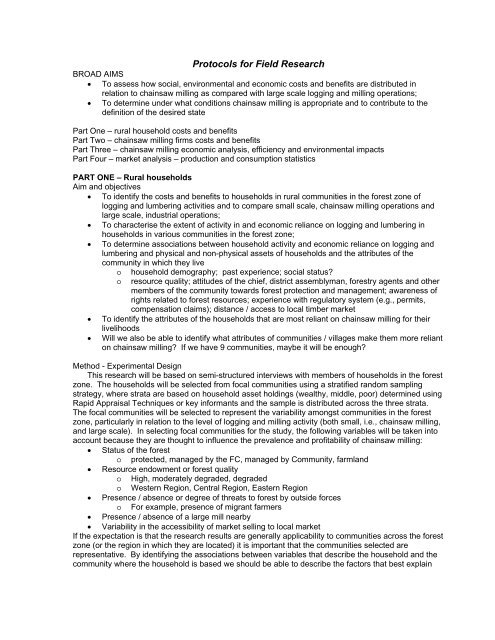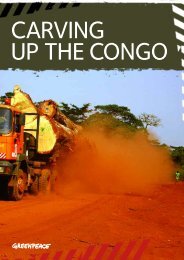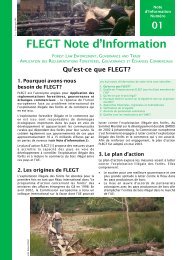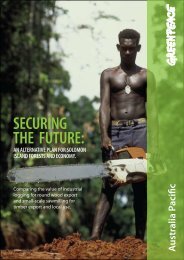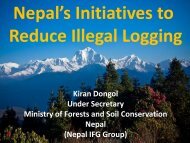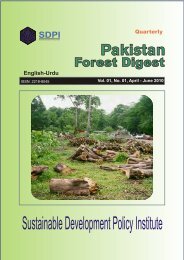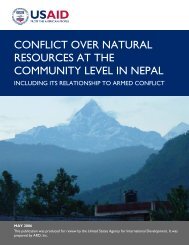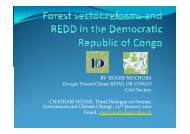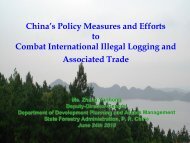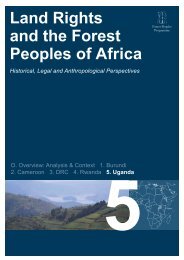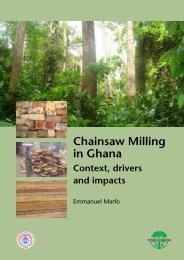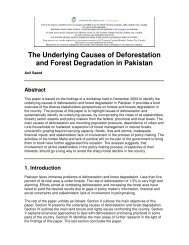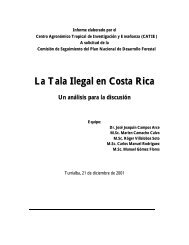chainsaw milling and lumber trade in west africa project
chainsaw milling and lumber trade in west africa project
chainsaw milling and lumber trade in west africa project
Create successful ePaper yourself
Turn your PDF publications into a flip-book with our unique Google optimized e-Paper software.
Protocols for Field ResearchBROAD AIMS• To assess how social, environmental <strong>and</strong> economic costs <strong>and</strong> benefits are distributed <strong>in</strong>relation to <strong>cha<strong>in</strong>saw</strong> <strong>mill<strong>in</strong>g</strong> as compared with large scale logg<strong>in</strong>g <strong>and</strong> <strong>mill<strong>in</strong>g</strong> operations;• To determ<strong>in</strong>e under what conditions <strong>cha<strong>in</strong>saw</strong> <strong>mill<strong>in</strong>g</strong> is appropriate <strong>and</strong> to contribute to thedef<strong>in</strong>ition of the desired statePart One – rural household costs <strong>and</strong> benefitsPart Two – <strong>cha<strong>in</strong>saw</strong> <strong>mill<strong>in</strong>g</strong> firms costs <strong>and</strong> benefitsPart Three – <strong>cha<strong>in</strong>saw</strong> <strong>mill<strong>in</strong>g</strong> economic analysis, efficiency <strong>and</strong> environmental impactsPart Four – market analysis – production <strong>and</strong> consumption statisticsPART ONE – Rural householdsAim <strong>and</strong> objectives• To identify the costs <strong>and</strong> benefits to households <strong>in</strong> rural communities <strong>in</strong> the forest zone oflogg<strong>in</strong>g <strong>and</strong> <strong>lumber</strong><strong>in</strong>g activities <strong>and</strong> to compare small scale, <strong>cha<strong>in</strong>saw</strong> <strong>mill<strong>in</strong>g</strong> operations <strong>and</strong>large scale, <strong>in</strong>dustrial operations;• To characterise the extent of activity <strong>in</strong> <strong>and</strong> economic reliance on logg<strong>in</strong>g <strong>and</strong> <strong>lumber</strong><strong>in</strong>g <strong>in</strong>households <strong>in</strong> various communities <strong>in</strong> the forest zone;• To determ<strong>in</strong>e associations between household activity <strong>and</strong> economic reliance on logg<strong>in</strong>g <strong>and</strong><strong>lumber</strong><strong>in</strong>g <strong>and</strong> physical <strong>and</strong> non-physical assets of households <strong>and</strong> the attributes of thecommunity <strong>in</strong> which they liveoohousehold demography; past experience; social status?resource quality; attitudes of the chief, district assemblyman, forestry agents <strong>and</strong> othermembers of the community towards forest protection <strong>and</strong> management; awareness ofrights related to forest resources; experience with regulatory system (e.g., permits,compensation claims); distance / access to local timber market• To identify the attributes of the households that are most reliant on <strong>cha<strong>in</strong>saw</strong> <strong>mill<strong>in</strong>g</strong> for theirlivelihoods• Will we also be able to identify what attributes of communities / villages make them more relianton <strong>cha<strong>in</strong>saw</strong> <strong>mill<strong>in</strong>g</strong>? If we have 9 communities, maybe it will be enough?Method - Experimental DesignThis research will be based on semi-structured <strong>in</strong>terviews with members of households <strong>in</strong> the forestzone. The households will be selected from focal communities us<strong>in</strong>g a stratified r<strong>and</strong>om sampl<strong>in</strong>gstrategy, where strata are based on household asset hold<strong>in</strong>gs (wealthy, middle, poor) determ<strong>in</strong>ed us<strong>in</strong>gRapid Appraisal Techniques or key <strong>in</strong>formants <strong>and</strong> the sample is distributed across the three strata.The focal communities will be selected to represent the variability amongst communities <strong>in</strong> the forestzone, particularly <strong>in</strong> relation to the level of logg<strong>in</strong>g <strong>and</strong> <strong>mill<strong>in</strong>g</strong> activity (both small, i.e., <strong>cha<strong>in</strong>saw</strong> <strong>mill<strong>in</strong>g</strong>,<strong>and</strong> large scale). In select<strong>in</strong>g focal communities for the study, the follow<strong>in</strong>g variables will be taken <strong>in</strong>toaccount because they are thought to <strong>in</strong>fluence the prevalence <strong>and</strong> profitability of <strong>cha<strong>in</strong>saw</strong> <strong>mill<strong>in</strong>g</strong>:• Status of the foresto protected, managed by the FC, managed by Community, farml<strong>and</strong>• Resource endowment or forest qualityo High, moderately degraded, degradedo Western Region, Central Region, Eastern Region• Presence / absence or degree of threats to forest by outside forceso For example, presence of migrant farmers• Presence / absence of a large mill nearby• Variability <strong>in</strong> the accessibility of market sell<strong>in</strong>g to local marketIf the expectation is that the research results are generally applicability to communities across the forestzone (or the region <strong>in</strong> which they are located) it is important that the communities selected arerepresentative. By identify<strong>in</strong>g the associations between variables that describe the household <strong>and</strong> thecommunity where the household is based we should be able to describe the factors that best expla<strong>in</strong>


